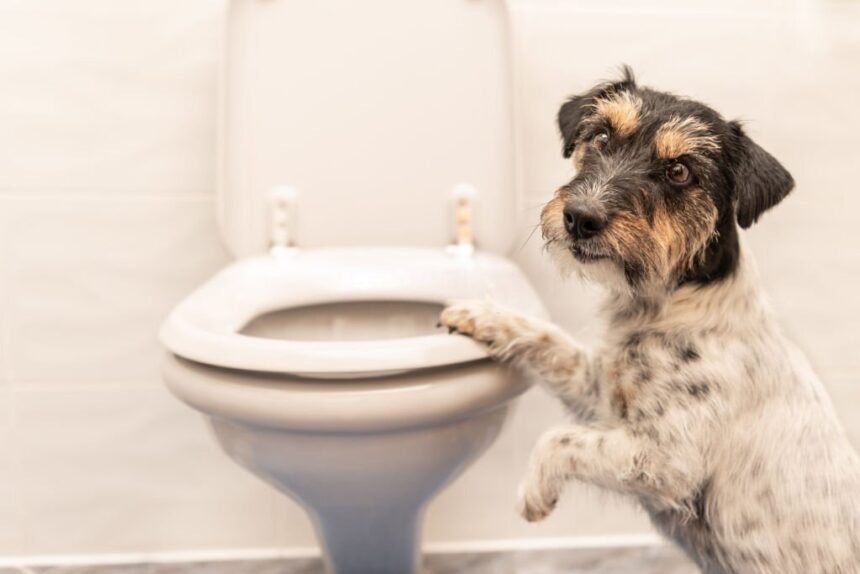Bringing a new puppy into your home is an exhilarating experience, filled with joy and anticipation. However, along with the boundless cuteness and playful antics, comes the responsibility of toilet training. A well-trained puppy is a happy puppy, and an essential aspect of this training is teaching them where and when to do their business.
In this comprehensive guide, we will provide you with ten expert tips to effectively toilet train your puppy. From understanding the importance of early training to celebrating their graduation from puppy toilet training, we will navigate through each critical step with precision and professionalism. By the end of this journey, you’ll be equipped with the knowledge and strategies necessary to ensure your puppy develops into a well-behaved and hygienic canine companion. Let’s embark on this educational journey to create a harmonious living environment for both you and your furry friend.
Understanding Puppy Toilet Training
- Importance of Early Training: Toilet training, also known as housebreaking, is a fundamental aspect of raising a well-behaved and hygienic puppy. It sets the foundation for a lifetime of good habits and a harmonious relationship between you and your pet.
- When to Start: The process of toilet training should commence as soon as you bring your puppy home, typically around 8 weeks of age. Puppies have limited bladder control, so initiating training early is essential.
- Patience is Key: Understand that accidents will happen during the training process. Maintaining a patient and positive attitude is crucial. Remember, your puppy is still learning, and consistent guidance is the key to success.
- Gradual Progress: Puppy toilet training is a gradual process that requires time and effort. Be prepared for several weeks of training before your puppy becomes reliably house-trained. Each puppy is unique, and the timeline may vary.
In this phase of puppy training, you’ll lay the groundwork for success by grasping the significance of timely training and the need for patience and consistency. Now, let’s delve into the specifics of creating a consistent routine.
Creating a Consistent Routine
- Setting Feeding Times: Establish a regular feeding schedule for your puppy. This helps regulate their bowel movements, making it easier to predict when they’ll need to go outside. Feed them at the same times each day, typically three to four meals for young puppies.
- Establishing Regular Bathroom Breaks: Consistency is key. Take your puppy outside to their designated bathroom spot after meals, upon waking up, and before bedtime. Puppies also often need to go after playtime. Use a leash to control the area they explore outside.
- Monitoring Water Intake: Control your puppy’s water intake in the evening to reduce nighttime bathroom trips. Remove the water dish a few hours before bedtime to minimize accidents during the night.
- Keep a Potty Journal: Maintain a record of your puppy’s bathroom habits. Note when they eliminate and the frequency. This journal can help you identify patterns and adjust your routine accordingly.
Creating a consistent routine is the cornerstone of successful toilet training. By establishing regular feeding and bathroom times, you’ll create a predictable environment that makes it easier for your puppy to learn where and when to go. Next, we’ll explore the importance of selecting the right outdoor spot.
Selecting the Right Outdoor Spot
- Choosing a Designated Area: Designate a specific spot in your yard or the outdoor area where you want your puppy to eliminate. Consistency is vital, as your puppy will associate this spot with the act of relieving themselves.
- Factors to Consider: When selecting the designated area, consider accessibility, safety, and convenience. Ensure it’s easily accessible for you, even in adverse weather conditions, and safe for your puppy to explore.
- Avoiding High-Traffic Areas: Steer clear of high-traffic areas where people or other pets frequently pass through. This reduces distractions and helps your puppy focus on their business.
- Use of Scent Markers: To further guide your puppy, you can use scent markers such as a specific type of grass or a designated potty pad. These scents can signal the appropriate area for elimination.
Selecting the right outdoor spot sets the stage for successful toilet training. It provides consistency and clarity for your puppy, making it easier for them to understand where they should go. Next, we’ll delve into positive reinforcement techniques to encourage desired behavior.
Positive Reinforcement Techniques
- Reward-Based Training: Utilize positive reinforcement to encourage your puppy to eliminate in the designated outdoor spot. When your puppy successfully goes potty in the right place, immediately reward them with praise and treats. This reinforces the behavior and helps them understand that this is the desired action.
- Timing and Treats: Timing is crucial. Reward your puppy immediately after they finish eliminating, not when they return indoors. Use small, tasty treats that your puppy loves. Consistency in rewards reinforces the positive association.
- Verbal Praise: Alongside treats, offer verbal praise with a cheerful and encouraging tone. Use phrases like “Good potty!” or “Well done!” This verbal reinforcement reinforces the connection between the behavior and the positive outcome.
- Stay Consistent: Consistency in your reward system is essential. Ensure that all family members use the same rewards and praise techniques to avoid confusion for your puppy.
Positive reinforcement is a powerful tool in toilet training your puppy. It creates a positive association with the desired behavior and motivates them to repeat it. Next, we’ll explore effective communication methods to better understand your puppy’s needs.
Effective Communication
- Reading Your Puppy’s Cues: Pay close attention to your puppy’s body language and behavior. Common signs that they need to eliminate include sniffing the ground, circling, or whining. Recognizing these cues allows you to respond promptly.
- Teaching Basic Commands: Basic commands like “outside” or “potty” can help your puppy understand what’s expected. Use these commands consistently when taking them to the designated outdoor spot. Over time, your puppy will associate these words with the act of eliminating.
- Timing is Everything: Timing is critical when communicating with your puppy. Use commands and cues at the right moment, such as just before they start to eliminate. This helps reinforce the connection between the action and your words.
- Patience and Encouragement: Be patient and encouraging throughout the process. Avoid scolding or punishment for accidents, as this can create fear or confusion. Instead, focus on positive reinforcement to motivate your puppy.
Effective communication is the bridge that allows you to understand your puppy’s needs and guide them in the right direction. By reading their cues and using consistent commands, you’ll enhance the training process. Next, we’ll discuss the importance of supervision and crating in toilet training.
Supervision and Crating
- The Role of Supervision: Close supervision is a key component of successful toilet training. Keep a close eye on your puppy, especially during critical times like after meals and when they wake up. This allows you to anticipate their needs and take them outside promptly.
- Proper Crate Training: Crates can be valuable tools in toilet training. A correctly sized crate creates a safe and comfortable space for your puppy. Dogs are naturally inclined to keep their sleeping area clean, so they are less likely to eliminate in their crate. Use the crate when you can’t supervise your puppy closely.
- Introduce Gradually: Introduce the crate gradually and make it a positive experience. Place toys, blankets, and treats inside to make it inviting. Never use the crate for punishment; it should be a place of safety and comfort.
- Use for Short Periods: Avoid leaving your puppy in the crate for extended periods. Puppies have limited bladder control, and they need regular breaks for bathroom trips and exercise.
Supervision and proper crate training are essential elements of toilet training. They create a controlled environment that helps prevent accidents and reinforces good behavior. Next, we’ll address how to deal with accidents when they do occur.
Dealing with Accidents
- Staying Patient and Calm: Accidents are a normal part of the toilet training process. When accidents happen, it’s essential to stay patient and avoid reacting with anger or frustration. Your puppy is still learning, and negative reactions can hinder their progress.
- Immediate Cleanup: Promptly clean up any accidents to remove the scent and discourage repeat incidents. Use enzymatic cleaners specifically designed for pet messes to effectively eliminate odors.
- Avoid Punishment: Never punish your puppy for accidents after the fact. They won’t understand why they’re being scolded, and it can create anxiety or fear. Instead, focus on prevention and positive reinforcement for desired behavior.
- Adjusting Your Approach: If accidents become frequent, it may be necessary to reevaluate your training routine. Consider adjusting the timing of bathroom breaks, increasing supervision, or seeking guidance from a professional dog trainer if needed.
Dealing with accidents gracefully is a crucial aspect of toilet training. Maintaining a patient and understanding attitude, coupled with immediate cleanup, helps your puppy learn and progress in their training. Next, we’ll discuss the importance of consistency across family members in the training process.
Consistency Across Family Members
- Ensuring Everyone is on the Same Page: Effective toilet training requires consistency among all family members or caregivers. It’s essential to establish and communicate a unified approach to training to avoid confusing your puppy.
- Using the Same Commands and Cues: Ensure that everyone uses the same verbal cues and commands when taking the puppy outside. This consistency helps the puppy recognize and respond to the expected behavior.
- Coordinating Feeding and Bathroom Breaks: Coordinate schedules to ensure that your puppy receives consistent feeding and bathroom breaks. This reduces the chances of accidents and reinforces the routine.
- Sharing Information: Keep each other informed about your puppy’s progress and any challenges encountered. Open communication ensures that everyone is aware of the training process and can provide support when needed.
Consistency among family members is vital for successful toilet training. When everyone follows the same guidelines and routines, your puppy will learn more quickly and efficiently. Now, let’s explore the gradual transition to independence in the training process.
Gradual Transition to Independence
- When and How to Allow More Freedom: As your puppy becomes more reliable with their toilet training, you can gradually grant them more independence indoors. Start by expanding their supervised areas one room at a time. Monitor their behavior closely during this transition phase.
- Monitoring Progress: Pay attention to your puppy’s behavior as you grant them more freedom. If accidents start to occur again, it may be a sign that you need to scale back and reinforce training in a smaller space before trying again.
- Maintain Consistency: Even as you grant more independence, continue to follow the established routine for feeding, bathroom breaks, and positive reinforcement. Consistency is essential to ensure your puppy retains their training.
- Celebrating Progress: Celebrate milestones in your puppy’s training journey. Graduating from puppy toilet training is a significant achievement, and it marks the beginning of a well-trained and housebroken dog.
The gradual transition to independence is a critical phase in toilet training. It allows your puppy to adapt to new environments within your home while maintaining the habits you’ve worked hard to establish. Next, we’ll discuss how to celebrate success and maintain good habits as your puppy grows.
Celebrating Success and Ongoing Maintenance
- Graduation from Puppy Training: When your puppy consistently eliminates in the designated spot and has minimal accidents, it’s time to celebrate their success. Graduation from puppy toilet training marks a significant milestone. Consider a special treat or a new toy as a reward.
- Maintaining Good Habits: While your puppy has learned the basics of toilet training, it’s essential to continue reinforcing good habits throughout their life. Stick to the routine, positive reinforcement, and consistent commands to ensure your dog remains house-trained.
- Regular Exercise and Mental Stimulation: Providing your dog with regular exercise and mental stimulation helps prevent boredom-related accidents. A tired and mentally engaged dog is less likely to engage in unwanted behaviors.
- Annual Check-ins: As your puppy grows into an adult dog, periodic check-ins on their training can be beneficial. Revisit the basics if necessary and address any new challenges that may arise.
Celebrating your puppy’s success and maintaining their good habits ensure a well-trained and happy adult dog. Consistency, positive reinforcement, and ongoing care are the keys to long-term success in toilet training.







